Grappa: The Often Misunderstood Italian Brandy

Like fashion, the realm of cocktails can be a fickle place. One day you're in, and the next you're out. But, just as happens on the runway, trends come and go — and come again. And each incarnation brings with it subtle nuances and updates on an old classic. Such is the case with Grappa. The Italian liqueur once known as a poor man's drink is having a moment, easing its way back into the spotlight and giving better-known digestifs like Sambuca and Limoncello a run for their money.
In 2022, Grappa earned an official nod from the International Bartender Association as the headline ingredient in the Ve.n.tO. The I.B.A.-recognized "New Era" cocktail is a blend of Grappa, fresh lemon juice, honey, and chamomile cordial — the first-ever Grappa-based cocktail to make the roster. But before we get carried away by the trendy new ways to savor the multi-layered tones of the age-old Italian liqueur, let's take a look back at where it all began.
Read more: The Best Wineries In The U.S.
How Is Grappa Made?
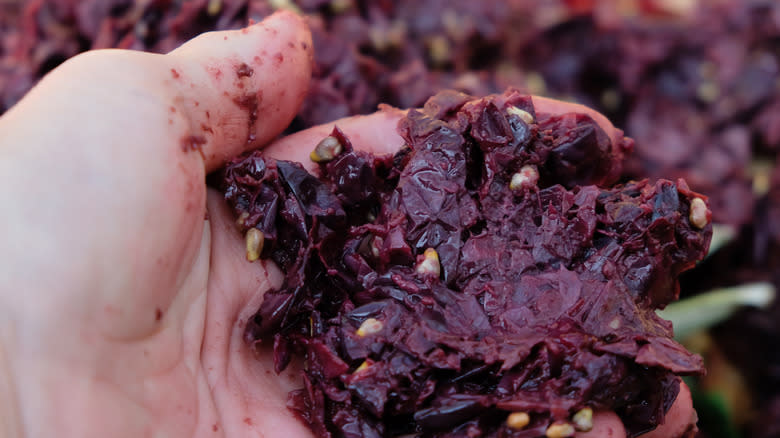
In the Middle Ages, Grappa was a quick fix for villagers looking for a cheap alternative to wine and more refined spirits. It was made using a down-and-dirty process that resulted in an astringent-like elixir likely valued more for putting a blurry focus on a difficult living situation than as a spirit to be savored, but by the late 19th-century Italian distillers began to see potential in the much-maligned tipple. Through a decades-long series of trial and error, they refined the process to produce the nuanced varieties of Grappa we know today.
Official regulations prohibit added water, so the process begins before the pomace (the pulpy residue left over after grapes are pressed for wine) loses its natural moisture. First, it's filtered to remove unsavory detritus. Then it's distilled using one of two accepted methods — a more modern process known as continuous distillation (used more for large-batch grappa) or discontinuous (the age-old method now more often employed by artisanal distillers). In either case, the distilled grappa is rested in vats for six months, then there's another fork in the road. Unaged grappa (giovane) is hydrated and bottled. Aged Grappa (Vecchia or invecchiata) is transferred to wooden casks and allowed to mature for at least a year. Grappa that's aged in barrels for at least 18 months earns the designation reserva or stravecchia.
What Does Grappa Taste Like?
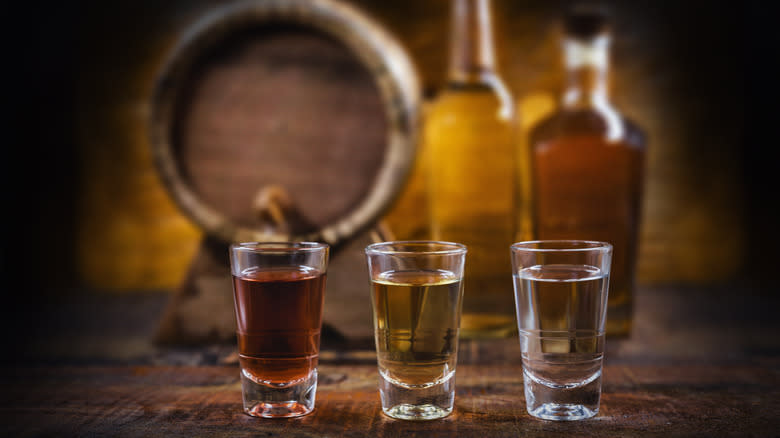
To the uninitiated, the thought of Grappa may still conjure the tear-inducing firewater it once was, but new and improved distillation practices have transformed the once vile beverage into something to be savored and enjoyed as an after-dinner drink and in cocktails. It's a fragrant elixir with a taste influenced by the grape — or grapes in blended varieties — that produced the primary ingredient, pomace. Like brandy and cognac, two grape-based cordials long considered top-shelf liqueurs, today's Grappa is a nuanced beverage influenced by where it's produced, the distilling method, and the aging process, among other factors. Flavors can range from fresh and floral to rich and chocolatey.
Experts suggest exploring Grappa's nuances layer by layer, first by focusing on aroma or bouquet. From scent alone, an experienced palate will be able to discern the varietal of the grape that produced the pomace, tuning into subtle hints about its provenance. The Grappa Guy advises swirling the Grappa before gently puffing across the top of the glass and taking a moment to savor the aroma, followed by a tiny sip to prepare your palate, then a second sip to savor the nuanced complexity. When it comes to taste, it would take an algorithm to define the myriad components that go into each individual blend. It usually tends toward the dry side but can be fruity depending on the grape of origin. Suffice it to say, there's something for everyone — but it may take a round or two of tastings to choose a personal favorite.
How To Cook With Grappa
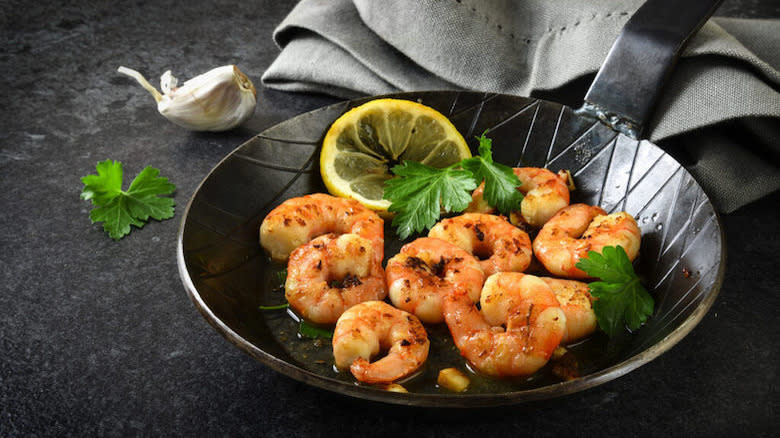
Throughout its history, Grappa has been first and foremost an alcoholic beverage made for drinking. Although it was a rough elixir in its earliest incarnations, it's evolved into a popular after-dinner tipple and, more recently, an interesting cocktail ingredient. But it can also add flavor and depth to everything from sauces to salad dressings. Celebrity chef Gordon Ramsay has been known to incorporate Grappa into a recipe for pork filet and has even used it to flavor rice served with prawns. It's also used as a flavoring in classic desserts like Italian almond cake or macerated cherries.
But like cooking with wine, sherry, or any spirit, the variety you choose will be dependent on the effect you want it to have, so a little bit of experimentation may be in order. In general, choose a lighter, dryer variety of Grappa when cooking with proteins like chicken. On the flip side, an aged and slightly sweet Grappa may be a better match for desserts and red meat. And don't completely rule out inexpensive Grappa. It may not be suitable for drinking or cooking complex dishes, but those varieties that harken back to its early days as a poor man's drink can still come in handy in the kitchen, adding flavor when it's used to deglaze a pan or to add depth to a stew.
Where To Buy Grappa
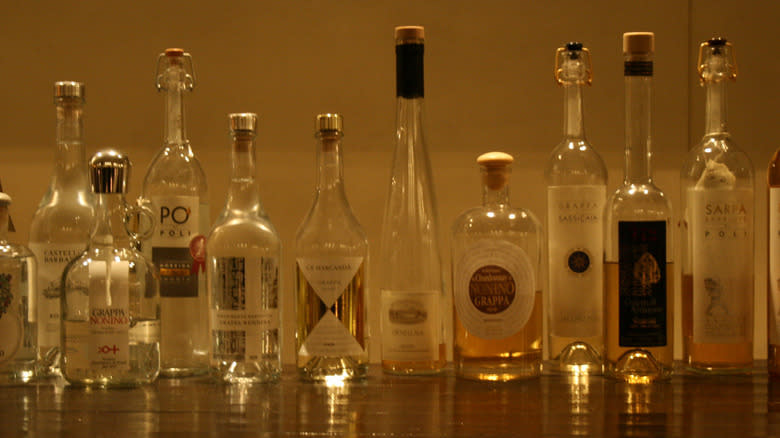
It wasn't long ago that Grappa was almost impossible to find in the United States. The distilled digestif produced in Italy according to strict guidelines due to its controlled designation status didn't have much of a following outside the country. But as the distillation and aging process for Grappa began to improve, so did its perception as a worthy after-dinner drink on par with fine sherries and cognacs. These days you're likely to find multiple varieties of Grappa at any major liquor store. If you come up empty, try an online liquor retailer like Drizly. Pricing ranges from less than $20 to upwards of $50 per bottle. To be sure you're getting authentic Italian Grappa, look for the controlled designation — or DOP — label on the bottle. Top brands include Poli Grappa Sarpa Di Poli, Nonino Vigneti Moscato, and Piave Selezione Cuore Grappa.
Even in Italy, it's a good idea to pay attention to what you're buying — especially if you're shopping in a grocery store. The Grappa Guy learned that lesson the hard way. While visiting Venice, the Grappa expert slipped into a market around the corner from their hotel to pick up a little tipple. Everything on the label of the bargain-priced brand was in order, but a tasting revealed a different story. The lesson: Even a Grappa expert can be fooled. Whether you're shopping in the U.S. or in the Grappa region of Italy, never hesitate to ask a knowledgeable clerk for advice.
Varieties Of Grappa
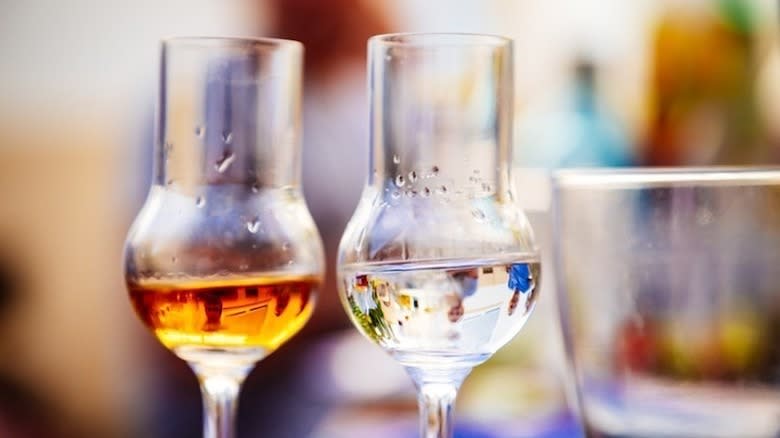
There are two primary categories of Grappa — aged and unaged — but within those primary designations, the varieties and nuances get more complex. We know pomace, the main ingredient in Grappa, is distilled and rested for up to six months. Grappa made from white grape pomace — the crystal-clear varieties you'll see on the shelf — are then bottled for sale. Grappa made from red grape pomace is aged for at least 12 months in wooden casks before it's ready for market. The next breakdown is based on aging. Unaged white grape Grappa is designated giovane/bianca (young, unaged Grappa). Red grape Grappa can be affinata in legno (briefly aged in casks), vecchia/invecchiata (aged for at least 12 months), and riserva/ stravecchia (aged for at least 18 months). A general rule of thumb, the longer it's aged, the more expensive the Grappa.
But that's not all. Grappa labeled aromatica indicates it's derived from aromatic grapes like Gewürztraminer, Riesling, and Sauvignon Blanc. If you see the word monovitigno on the label, that means you're looking at Grappa made from a single variety of grapes. Aromatizzata means the Grappa has been infused with herbs or fruit. Look closely and you may notice a reference to the geographic source of the grapes, like Grappa del Friuli or Grappa del Veneto. And just when you think you've got it down pat, here's another curveball: Artisanal distillers may combine styles to create a signature blend. With so many potential variations, and with distillers consistently looking for ways to improve their product, it's best to look at exploring the world of Grappa as a journey, not a destination.
Nutritional Information About Grappa
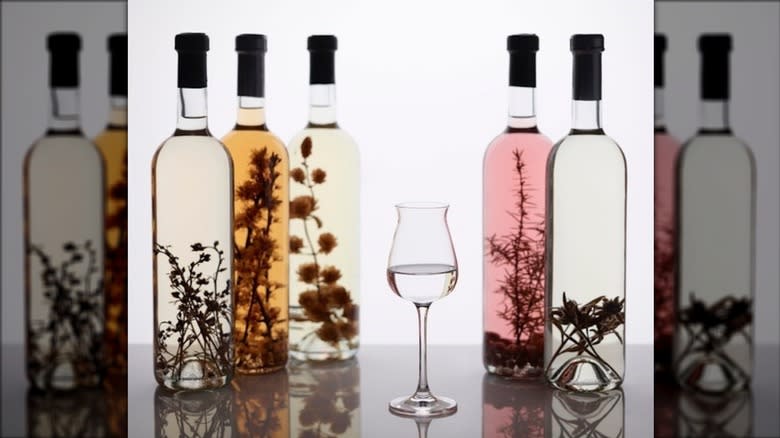
While it's always best to enjoy alcoholic beverages in moderation, there's some evidence Grappa has a few checks in the positive column when it comes to redeeming qualities. It's high in antioxidants, those mighty compounds that protect the body from free radicals that can lead to cell degeneration and disease. It's also rich in potassium and magnesium and has anti-inflammatory properties to stave off the inflammation that, left unchecked, can lead to damaged cells and internal scarring, and open the door to chronic diseases like type-2 diabetes.
While its protected geographical indication status allows for 37.5% to 86% alcohol by volume, most Grappas measure about 40%. That is high compared to beer, which averages 4% to 7%, or wine, usually 11% to 13%, but on par with distilled spirits like gin or vodka. A standard 1.5-ounce serving of Grappa averages 97 calories, which is also on par with other distilled beverages.
It's interesting to note that Grappa was initially considered a medicinal remedy. In the Middle Ages, it was used to treat everything from gout to the plague. We can't vouch for its effectiveness, but it's a good bet a swill of Grappa at least eased the pain of the malady. In some circles, Grappa infused with medicinal herbs is still considered a therapeutic remedy.
How To Drink Grappa?
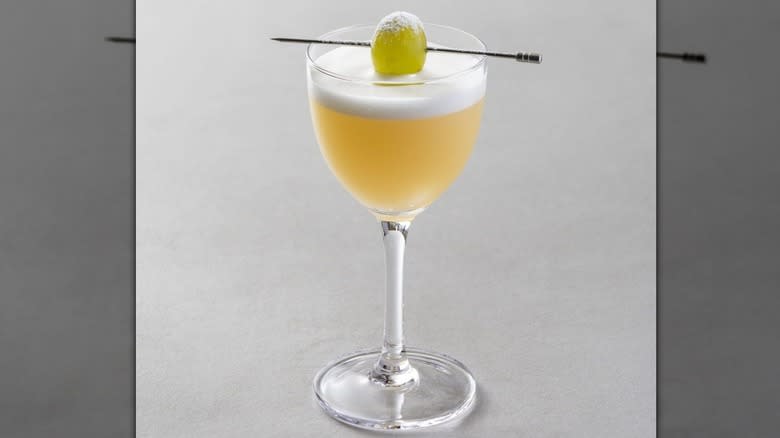
Historically, Grappa has been considered a digestif, a drink to be enjoyed after a meal with dessert, coffee, or on its own served in a stemmed tulip-shaped cordial glass. Ideally, it should be poured about 15 minutes prior to drinking. Young Grappa (giovane) is best served slightly chilled at about 50 degrees Fahrenheit. The nuances of aged Grappas are most discernible at about 60 degrees Fahrenheit. Connoisseurs often dip the tip of a finger into the glass to savor the aromas released as the Grappa evaporates. Although it's usually served as an after-dinner drink, it's also not unheard of to imbibe in a morning tipple on occasion. Caffè corretto is espresso boosted with a few drops of Grappa. Or if that's too much, try adding a resentin (little rinser), a quick swish of Grappa swirled in an empty espresso cup.
Which brings us to cocktails. The Ve.n.tO. may be the first I.B.A.-recognized Grappa cocktail, but it's unlikely to be the last. According to Difford's Guide, other Grappa-centric cocktails include Affogato (a blend of Grappa, coffee liqueur, cacao liqueur, espresso, and vanilla ice cream) and Grapparita (a Margarita-esque drink made with Grappa, limoncello, lemon juice, and egg white).
Read the original article on Tasting Table.
